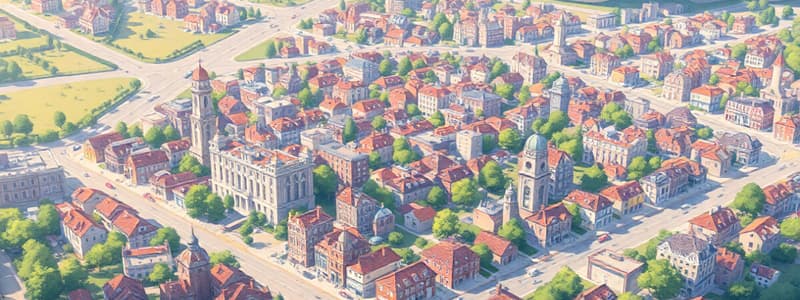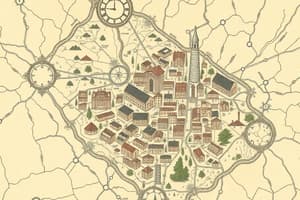Podcast
Questions and Answers
What is the primary purpose of a Local Area Plan (LAP)?
What is the primary purpose of a Local Area Plan (LAP)?
- To improve and enhance existing developed areas (correct)
- To prevent any future development in urban areas
- To create entirely new cities from scratch
- To promote exclusively rural development
Which of the following does the LAP mechanism enable cities and urban authorities to do?
Which of the following does the LAP mechanism enable cities and urban authorities to do?
- To decentralize populations to rural areas
- To ignore existing infrastructure
- To re-plan, revive, and regenerate existing developed inner city areas (correct)
- To exclusively focus on developing suburban areas
What scale of planning tool is the LAP mechanism?
What scale of planning tool is the LAP mechanism?
- Global-level
- Micro-level (correct)
- National-level
- Macro-level
Which of the following is NOT a component of the LAP mechanism?
Which of the following is NOT a component of the LAP mechanism?
When conceptualizing the LAP process, what should be prioritized?
When conceptualizing the LAP process, what should be prioritized?
Which type of area is NOT typically a focus of Local Area Plans?
Which type of area is NOT typically a focus of Local Area Plans?
What is the first step in establishing proposals for future development in an area selected for LAP?
What is the first step in establishing proposals for future development in an area selected for LAP?
Which of the following best describes a Local Area Plan?
Which of the following best describes a Local Area Plan?
What is the goal of a Local Area Plan for transit-oriented development?
What is the goal of a Local Area Plan for transit-oriented development?
What is the purpose of a Local Area Plan for Special Development Areas?
What is the purpose of a Local Area Plan for Special Development Areas?
In which phase of LAP are the problems of relevance identified?
In which phase of LAP are the problems of relevance identified?
Which element is NOT typically included within the design of a urban area under LAP?
Which element is NOT typically included within the design of a urban area under LAP?
What is the main criteria that requires to be promoted ease its implementation during consultation with multiple stakeholders?
What is the main criteria that requires to be promoted ease its implementation during consultation with multiple stakeholders?
For what domain the Local Area Plans cannot be used?
For what domain the Local Area Plans cannot be used?
To regulate the private development, what is the LAP mechanism based on?
To regulate the private development, what is the LAP mechanism based on?
Flashcards
What is a Local Area Plan (LAP)?
What is a Local Area Plan (LAP)?
A statutory planning mechanism designed to improve and enhance existing developed areas by addressing issues and providing detailed planning proposals.
What is the purpose of the LAP mechanism?
What is the purpose of the LAP mechanism?
To re-plan, revive, and regenerate existing developed inner city areas.
How does LAP implement the DP vision?
How does LAP implement the DP vision?
A micro-level planning tool that implements the larger vision of the Development Plan (DP) in specific areas through plot reconstitution, urban design, and form-based regulations.
What are the different types of Local Area Plans?
What are the different types of Local Area Plans?
Signup and view all the flashcards
What steps are involved in the LAP process?
What steps are involved in the LAP process?
Signup and view all the flashcards
What is a LAP for Improving Urban Areas with Heritage Value?
What is a LAP for Improving Urban Areas with Heritage Value?
Signup and view all the flashcards
Study Notes
- A Local Area Plan (LAP) is a statutory planning mechanism.
- LAPs are designed to improve and enhance existing developed areas.
- LAPs aim to improve, retrofit, and/or solve issues in currently developed areas.
- LAPs provide detailed planning proposals and policies for areas expected to undergo substantial redevelopment and transformation.
- LAPs enable cities and urban authorities to replan, revive, and regenerate existing developed inner-city areas.
- LAPs are a micro-level planning tool.
- LAPs implement the larger vision embedded in the Development Plan (DP) for specific areas.
- LAPs involve: plot reconstitution, Master Planning, designing urban areas, and regulating private development using form-based regulations.
- The LAP process requires consultation with multiple stakeholders and plot-owners.
- It should be conceptualized to incentivize and promote redevelopment for easier implementation.
- The types of Local Area Plans include: urban regeneration of developed areas, transit-oriented development, improving urban areas with heritage value, improving areas with informal settlements, and special development areas.
- LAPs can also be for special purpose areas like religious tourism, healthcare tourism, knowledge precincts, and institutional areas.
- The area selected for an LAP is studied in detail to identify and analyze relevant issues before establishing proposals for future development.
Studying That Suits You
Use AI to generate personalized quizzes and flashcards to suit your learning preferences.




